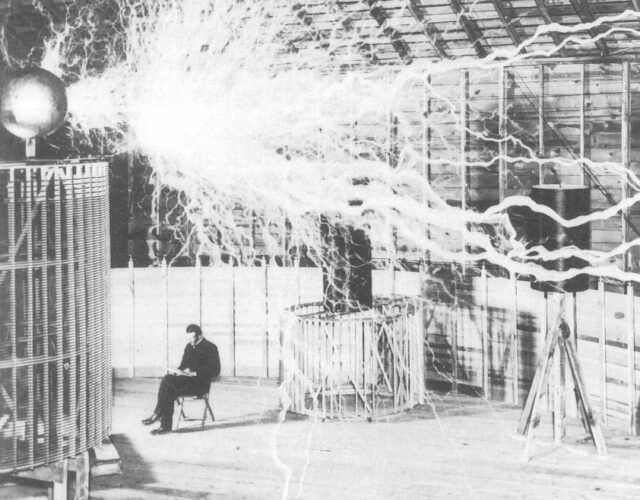W. Bernard Carlson. Tesla: Inventor of the Electrical Age. Princeton: Princeton University Press, 2013. 500 pp. $29.95.
Few figures in the history of technology have oscillated more dramatically between celebrity and obscurity than Nikola Tesla. During the mid-1890s the Serbian-born electrical inventor was the toast of the New York social scene, hobnobbing with the likes of Mark Twain and J. P. Morgan. Within two decades he was bankrupt, eking out a modest living from patent royalties before dying a recluse in 1943. Beyond occasional references to his rivalry with Thomas Edison, Tesla vanished from the historical limelight, only to experience a surge in popularity at the dawn of the 21st century. Movies and novels presented him as a visionary rebelling against Gilded Age capitalism, and people started celebrating Tesla as an embattled genius and countercultural icon.
The growth of Tesla’s popularity has complicated efforts to evaluate his achievements on their own terms. W. Bernard Carlson’s new biography strips away the layers of accumulated mythology to provide broader insights into technological innovation. His goal is to explain both Tesla’s successes—such as the alternating current (AC) motors and generators that undergird our modern electrical system—and failures, such as his dreams of wireless power transmission.
These two case studies illustrate the fundamental tension that defined Tesla as an inventor: a struggle to reconcile ideals and illusions. From a young age Tesla demonstrated an impressive visual imagination that enabled him to create detailed mental pictures of machines and seek out the “ideal,” or underlying principle, behind their operation. Throughout his career he endeavored not only to translate these mental images into working devices but to persuade others of their value. To accomplish the latter he became expert at crafting what Carlson terms illusions: descriptions or demonstrations intended to garner support from the scientific community, potential backers, and the general public.
Consider the example of Tesla’s first great invention: a practical AC motor. As a young engineering student in Graz, he watched professors operate direct current (DC) motors, which relied on sparking connections that tended to wear out over time. Tesla brainstormed various means of generating motion without sparks before settling on one that used AC voltages to create a rotating magnetic field that, in turn, spun a rotor.
Tesla later described how “wonderfully sharp and clear” images of this motor appeared in his head (fully formed!) during an afternoon walk in Budapest. Rather than accept this account at face value, Carlson instead outlines how established scientific principles enabled the inventor to recognize how to translate his ideal of a rotating magnetic field into practice. He also observes that at the time of this eureka moment Tesla possessed no experience building electrical machines.
Even after immigrating to the United States in 1884 and assembling a prototype motor, Tesla found himself at a loss when it came to its commercialization. To establish credibility he had to show that his inventions could exceed the performance of existing DC equipment. He did so by gradually molding public expectations about the long-term potential of AC systems through his patents, interviews, and demonstrations, like the so-called egg of Columbus. Building off of the legend that the Italian navigator won over Queen Isabella of Spain by successfully balancing an egg on one end, Tesla showed curious investors a copper egg that spun itself upright under the influence of a rotating magnetic field. Such illusions proved vital to the Westinghouse Company’s 1888 decision to purchase Tesla’s patents and to the subsequent rise of the AC power grid.
Tesla was an effective showman, and his spark-filled lectures proved one of the most popular attractions of the 1893 Chicago World’s Fair. His love of illusions, however, blinded him to practical concerns later in his career. This shortcoming was particularly evident in his quest for wireless power transmission. As with the AC motor, Tesla began with an ideal: resonance, the principle of matching the frequencies of electrical signals so they produce the maximum possible output. He theorized that one could send power—or messages—through the Earth itself by transmitting signals at the planet’s natural resonant frequency. By 1899 he was boasting to reporters that this system would enable people “to send a 2,000 word dispatch from New York to London, Paris, Vienna, Constantinople, Bombay, Singapore, Tokio [sic] or Manila” in less time than it took to contact a local telephone operator (p. 261).
Over the next six years this notion drove Tesla to create new high-frequency oscillators (the “coils” that later shared his name) and to set up larger laboratories in Colorado and Long Island. Yet throughout these investigations Tesla’s fascination with wireless power transmission led him to ignore growing evidence of his scheme’s impracticality, most notably its inability to function over long distances. Once again he attempted to win over the public, but his increased reliance on photographic evidence to highlight the vast amounts of power involved rather than in-person demonstrations proved less compelling.
Carlson’s book stands out compared with previous Tesla biographies, which have typically emphasized the popular debates surrounding the merits of AC and DC power systems. The choice to downplay the “War of the Currents” reflects the author’s interest in Tesla’s technical achievements, which also explains his decision to consolidate the final four decades of the inventor’s life into a single chapter. Carlson does, however, acknowledge the incidents that contributed to Tesla’s future reputation for eccentricity, such as his claims to have picked up extraterrestrial messages and to have designed a particle-beam weapon. The result is an eminently readable history that, while avoiding hagiography, reconstructs the intellectual development of one of history’s great electrical inventors and the social contexts in which he worked.




